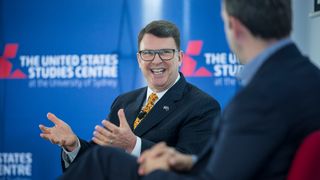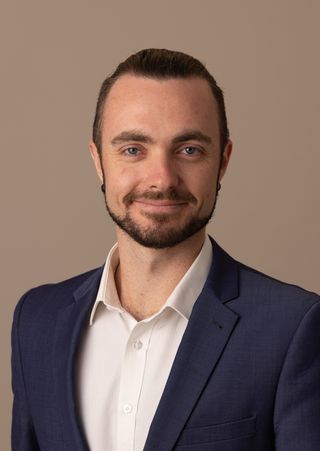The ongoing absence of a US ambassador to Australia has generated plenty of political and academic debate over whether or not the Trump administration is taking the ANZUS alliance seriously. While the current vacancy is the longest in the history of Australia-US relations, it is not without precedent. This is the third instance in which Australia has found itself without a US envoy in Canberra for 12 months or longer: there was an 18-month gap between the resignation of Tom Schieffer in February 2005 and the arrival of his replacement Robert McCallum in August 2006, and before that a vacancy of approximately 12 months between William Battle and Edward Clark in 1967-68. Whoever is nominated as the 24th US ambassador to Australia will still need to pass Senate confirmation, meaning that it will be several months yet before an ambassador arrives in Canberra.
The following research provides an overview of each former US ambassador to Australia, chronicling their respective professional backgrounds, the highlights of their time in Canberra, and their personal relationships with sitting US presidents. History shows that presidents have preferred to nominate figures with whom they have shared a personal relationship, ahead of professional members of the foreign service. Presidents of both political parties – but particularly Republicans – have regularly appointed male friends, business partners or campaign financiers. There has only been one woman and one African-American US ambassador to Australia. Only five of the 23 ambassadors have been professional diplomats, three of whom served in succession under President Clinton from 1993-2001. Additionally, only one appointee left Congress to take up the ambassadorship, back in 1949.
If history is an accurate template for the future, President Trump will likely nominate a friend or campaign donor, rather than a member of Congress or career foreign service officer, as the next US ambassador to Australia.
Morrell John Berry
25 September 2013 — late September 2016
Public servant and conservationist
Barack Obama
Reassigned from his position as director of US Office of Personnel Management under President Barack Obama, John Berry was well-received in Australia due in no small part to his personalised introductory video. Berry already held Australia in high regard due to his father’s experiences as a visiting US Marine during WWII, and apparently nominated the Canberra mission as his ideal posting when offered a choice by the president. Berry’s history as director of the National Zoo (2005-09) and of the National Fish and Wildlife Foundation (2000-05) greatly informed his focus on improving bilateral cooperation in science and conservation and building greater American ecotourism in Australia. The first openly gay ambassador to Australia, Berry was particularly generous in his praise of Australia’s leadership on LGBTQ rights, and engaged extensively with that community across the country. However, Berry was not all smiles with Canberra. Towards the end of his time in the office, he expressed Washington’s concerns over Canberra’s inability to reform its political donation laws, urging Canberra to protect itself from “undue influence from governments that don’t share our values”.
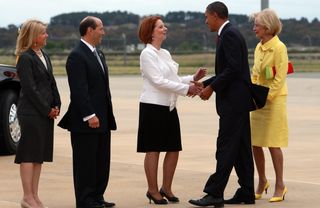
Jeffrey Laurence Bleich
26 November 2009 — 12 September 2013
Lawyer and political campaigner
Barack Obama
A longtime colleague and supporter of Barack Obama, Bleich founded and served as the co-chair of the Obama presidential campaign’s national finance committee and higher education advisory board, and later as the president’s special counsel within the White House prior to his appointment as ambassador to Australia. Unlike many of his predecessors, Bleich had visited Australia several times before his appointment, and as special counsel to the president had advocated Seeking out Australian expertise in formulating national responses to the H1N1 virus outbreak and in managing Californian wildfires. During his ambassadorship Bleich oversaw record growth in bilateral trade, the ratification of the Defense Trade Cooperation Treaty, and the incorporation of cyber security into the ANZUS treaty. Obama delivered the Asia Pivot speech to the Australian Parliament midway through Bleich’s tenure, and the ambassador stated on several occasions that he regarded the implementation of the Asia Rebalance strategy, in which Australia figured as the “centre of gravity”, as his greatest achievement in the post. Bleich’s achievements as ambassador led former Prime Minister Paul Keating to praise him as “the best US ambassador ever sent to Australia”. In turn, Bleich later praised Australia as an exemplary democracy and highlighted universal voting model, education systems and gun control laws as particularly impressive.
Robert Davis McCallum Jr.
24 August 2006 — 20 January 2009
Lawyer and public servant
George W. Bush
A close confidant of George W. Bush, Robert McCallum was a former lawyer and associate at Alston, Miller & Gaines, the practice co-founded by former ambassador to Australia Philip Alston. McCallum assumed the ambassadorship after an 18-month vacancy following the departure of Tom Schieffer, until then filled by Charge d’Affaires William Stanton. The delay was attributed to the fact that McCallum had been embroiled in a controversy regarding legal proceedings brought against American tobacco companies by the Justice Department. In fact, several of Bush’s other administrative nominees had faced similar delays due to their personal reluctance to face Senate confirmation, or because of problems identified with their candidacy by the State Department.
En route to Canberra, McCallum told reporters that implementing the US-Australia FTA was a secondary objective behind military cooperation. However, the ambassador’s lack of prior experience with Australia was accentuated in his first National Press Club appearance, when he admitted that he had not read the ANZUS Treaty. After the Howard government lost power in 2007, McCallum worked with Prime Minister Rudd to ensure that the latter’s election pledge to wind back troop deployments from Afghanistan would occur in coordination with allies and at a sustainable pace, though the ambassador also experienced difficulty in this relationship due to his judgement that the Prime Minister was more concerned about the media cycle than with collaborative decision-making. McCallum flagged months before Bush’s term expired that he would vacate the office, citing a lack of a close relationship between himself and either presidential candidates Obama or McCain, and the importance of such a dynamic in the context of alliance diplomacy.
John Thomas Schieffer
23 August 2001 — 18 February 2005
Lawyer and businessman
George W. Bush
Tom Schieffer was a friend and former business partner of George W. Bush, while he had also been elected to three terms in Texas House of Representatives, and had been active across multiple political campaigns. He came to office a month before 9/11, events which would largely define his agenda as ambassador. Schieffer worked closely with Prime Minister John Howard to invoke the ANZUS Treaty as justification for Australian contributions to the subsequent US invasion of Iraq — Howard apparently offered Schieffer a verbal guarantee of Australian support aboard Air Force 2 prior to the official invocation of ANZUS five days after the attacks. Canberra’s military obligations to Washington under ANZUS were the source of a number of public spats between Schieffer and Labor politicians. The ambassador traded verbal blows with party leaders Simon Creen (February 2003) and Mark Latham (June 2004) after both had accused Schieffer of interference in domestic politics and had cast doubt over Australia’s commitments to US-led military campaigns abroad under a Labor government. Schieffer later slapped down Foreign Minister Alexander Downer (August 2004) when the latter suggested while visiting Beijing that Canberra would not be obliged to assist Washington in the event of conflict with China over Taiwan. Schieffer’s tenure was not entirely divisive. He also oversaw the conclusion of the Australia-US Free Trade Agreement in May 2004, and had a hand in building a closer trilateral security relationship between Australia, Japan and the United States, something he continued to campaign for as ambassador to Japan between 2005 and 2009.

Edward William Gnehm Jr.
30 August 2000 — 22 June 2001
Career foreign service
Bill Clinton
Edward Gnehm’s ten-month tenure as ambassador to Australia was one of the shortest on record — most available information on or by Gnehm concerns his involvement with US Middle Eastern and European affairs rather than his activities in Australia. Nevertheless, Gnehm was highly qualified for the ambassadorship having formerly served as ambassador to Kuwait, as Deputy Assistant Secretary of State, as Deputy Assistant of Defense for Near East and South Asia, and as the Director General of the Foreign Service. During his brief stay in Canberra, Gnehm pushed hard for Australia to integrate a common submarine combat operating system into its fleet, and to contribute to the development of a collaborative missile defence system in the context of ongoing negotiations over the Australia-US Free Trade Agreement.
Genta Hawkins Holmes
11 April 1997 — 23 July 2000
Career foreign service
Bill Clinton
Ending the nine-month vacancy that followed the departure of Ambassador Perkins, Holmes was the first woman to serve as Canberra Chief of Mission, boasting a distinguished career including postings as US ambassador to Namibia (1990-92) and as director general of the Foreign Service (1992-1995). Her appointment was also a rarity in that she directly preceded and succeeded other career foreign service appointees. While Holmes praised Prime Minister Howard’s commitment to the defence aspects of the alliance, the two clashed more frequently on other issues. One of Holmes’ first acts as ambassador was to criticise Australia’s economic cost assessments of its Kyoto Protocol commitments, its reliance upon fossil fuels and reluctance to embrace renewable energy resources.
Edward Joseph Perkins
24 November 1993 — 19 July 1996
Career foreign service
Bill Clinton
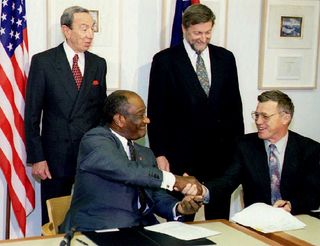
The first African-American ambassador to Australia, Perkins boasted a decorated foreign service career prior to arriving in Canberra, including positions on the Bureau of Far East and South Asian Affairs (1974-75), as ambassador to South Africa (1986-89) during the apartheid era, and as director general of the Foreign Service (1989-1992). While Perkins claims that the Australia posting was the only position he ever actively sought out, President Clinton informed Prime Minister Keating early on that Washington was sending one of its best and brightest to Canberra to demonstrate the esteem with which the alliance was regarded. Perkins quickly proved his worth to Australia, securing PACOM Commander Ronald Zlatoper as Washington’s representative at the annual Coral Sea Celebrations in Australia in 1995 after Canberra was underwhelmed by Clinton’s choice of representative in 1994. While Perkins spent much of his posting negotiating bilateral trade issues, he also campaigned extensively for indigenous rights and services in health, governance, law and order, education, and culture.
Melvin Sembler
25 October 1989 — 28 February 1993
Political fundraiser/campaigner
George H.W. Bush
Sembler’s appointment was consistent with President Bush Senior’s particularly notable habit of nominating friends and donors for key government posts: a staggering 70 per cent of his initial picks were political rather than career nominees (compared to Reagan’s 59 per cent). In fact, Sembler — the Chairman of a shopping centre development and management company — was accused of ‘purchasing’ the ambassadorship through a $100,000 contribution to the Bush Snr presidential campaign shortly before his appointment, and was a long-term financial supporter of the Republican Party. Sembler nonetheless proved an effective ambassador despite his diplomatic inexperience, ensuring that Bush made the first state visit by a US president to Australia in more than 20 years between 31 December 1991 - 3 January 1992 and setting the precedent for more regular presidential visits. This visit came at a controversial time in Australian politics, for Paul Keating had ousted Bob Hawke as prime minister only 11 days prior to Bush’s arrival. Nevertheless, the president’s visit was a success, and he became the first US president to address the Australian Parliament. Sembler was later named as Honorary Officer of the Order of Australia in 2000 for his services to Australian-US relations.
Laurence William Lane Jr.
7 January 1986 — 29 April 1989
Businessman
Ronald Reagan
Ending an eight-month vacancy in Canberra, Lane was appointed as ambassador to Australia in 1985 by Ronald Reagan. Lane and Reagan were already familiar, for Lane had briefed the former California governor ahead of his tour of the Pacific as Nixon’s representative in the 1970s and the two had developed a close friendship over a mutual interest in horse-riding and the California wilderness. Lane also had the advantage of ambassadorial experience prior to arriving in Canberra, having served as US ambassador-at-Large between 1975-76. He was well-received and renowned for being tough but respectful with his Australian interlocutors, qualities which proved crucial in prosecuting a series of challenging trade negotiations over rice, sugar, and the political dynamics of Australia’s grain trade with the Soviet Union. Lane was also instrumental in facilitating the first address by an Australian prime minister (Bob Hawke) to a joint congressional sitting in 1988, and was later awarded the Order of Australia for his services to the alliance.
Robert Dean Nesen
17 June 1981 — 2 May 1985
Businessman and public servant
Ronald Reagan
Having worked on long-time friend Richard Nixon’s presidential campaign (1968) and as assistant secretary of the Navy (1972-1974), Nesenlater served as chairman of the California delegation at the Republican National Convention in 1980, and was the next year appointed ambassador to Australia by President Ronald Reagan. However, a continuation in the pattern of Republican presidents appointing political supporters to the Canberra Mission, rather than qualified foreign service personnel, once again stoked dissatisfaction in Australia — Nesen was criticised by the media for reportedly failing to answer basic questions about the alliance or Australian interests at his first press conference as ambassador in Canberra.
Nesen was criticised by the media for reportedly failing to answer basic questions about the alliance or Australian interests at his first press conference as ambassador in Canberra.
Nesen's tenure coincided with the MX missile testing controversy. Prime Minister Malcolm Fraser had covertly agreed in 1981 to provide logistical support to Washington’s proposed test-firing of nuclear-capable rockets from the coast of California into waters 220km off the coast of Cape Pillar in Tasmania. While Bob Hawke reaffirmed Australia’s agreement during a visit to Washington in November 1983, he was forced to withdraw this commitment in February 1985 after public and political backlash against revelations that Australia would provide logistical support and allow American planes to monitor these tests out of Australian facilities. This coincided with another strategic setback for the United States in the region, after the New Zealand government had refused to allow the nuclear-equipped USS Buchanan to access its ports in February 1985.
Phillip Henry Alston Jr.
23 May 1977 — 23 January 1981
Lawyer and political lobbyist
Jimmy Carter
Alston is another figure whose exact achievements as ambassador are difficult to verify. A close confidant of Jimmy Carter, prior to his appointment Alston was chairman of Carter’s gubernational bid in 1970 and was chairman of the Committee for Carter during the successful 1976 presidential campaign. Alston was another ambassador whose posting commenced in difficult circumstances, in the midst of a controversy stemming from revelations that four diplomats at Washington’s mission in Canberra were CIA agents, as well as allegations that Washington had played a clandestine role in the Whitlam dismissal. Prior to assuming the Australia posting, Alston was a practicing lawyer who co-founded the Alston, Miller and Gaines law practice in 1942, the same firm that later produced ambassador McCallum (2006-2009).
James W. Hargrove
19 February 1976 — 8 March 1977
Businessman and public servant
Gerald Ford
Immediately prior to becoming ambassador, Hargrove had served as assistant postmaster general in the Nixon and Ford administrations between 1970 and 1976, playing a major role in enacting the Postal Reorganisation Act of 1970. Hargrove’s appointment as ambassador by President Ford in 1976 reportedly stoked discontent within Australia — he was dubbed ‘the unknown American’ by one media publication — due to perceptions that recurring appointments of non-career ambassadors to the Canberra mission signified Washington’s neglect of the Australia relationship. Hargrove was by his own account aware of the importance of the appointment given the credentials of his predecessor Marshall Green and the seven-month vacancy following Green’s departure. Indeed, the turmoil generated by the Australian constitutional crisis and Whitlam dismissal in late 1975 only added to the ambassador’s imperative of stabilising the ANZUS alliance. Aside from ANZUS, Hargrove’s priorities included the beef and sugar trades, as well as building a trilateral trade relationship between Australia, Japan and the United States. Hargrove was also reportedly tasked by director of Naval Reactors Admiral Rickover with securing access for US nuclear-powered vessels to Australian ports, with some success — the nuclear carrier USSEnterprise docked in Hobart in October 1976.
Marshall Green
8 June 1973 — 31 July 1975
Career foreign service
Richard Nixon, Gerald Ford
Green is perhaps the most well-known and celebrated of all US ambassadors to Australia. Even before he arrived in Canberra, Green already boasted a decorated foreign service career, having spent time at US embassies in Japan (1939-41), South Korea (1960) and Indonesia (1965-1969), and as the Assistant Secretary of State for East Asian and Pacific Affairs (1969-1973). Green was assigned to Australia in 1973 at a time when the alliance was under strain, due in part to uncertainties generated by the ‘Nixon Doctrine’ and with the election of the Whitlam Labor government in 1972. Green nevertheless saw Australia as an exemplar for other US allies in Asia, and promptly urged the White House to end its freeze on alliance diplomacy so as not to endanger America’s key interest in maintaining military and communications facilities on Australian soil.
While many Australian accounts portrayed Green’s appointment as something of a ‘trophy’ from Washington, there have been suggestions that he was in fact dispatched to Australia by Secretary of State Henry Kissinger in a tactical move to remove him as a competitor for the ear of President Nixon.
While many Australian accounts portrayed Green’s appointment as something of a ‘trophy’ from Washington, there have been suggestions that he was in fact dispatched to Australia by Secretary of State Henry Kissinger in a tactical move to remove him as a competitor for the ear of President Nixon. Nevertheless, Green is credited one way or another with rescuing the alliance, either by ‘repairing’ the strained bilateral relationship through skilled diplomacy or simply putting Canberra back in the ‘compliance camp’. Upon his departure, in a letter to Secretary of State Kissinger, Marshall mused that the single biggest lesson gleaned from the ambassadorship was that complacency was Washington’s biggest challenge in managing the relationship with Canberra.
Walter Lyman Rice
11 September 1969 — 26 May 1973
Public servant
Richard Nixon
Walter Rice served in the US Justice Department prior to his appointment as ambassador to Australia by President Nixon (1969). However, while he occupied the ambassadorship for close to four years, Rice was eventually removed from the post because he had not developed significant relationships with influential Australian ministers, nor had he enlightened the Nixon administration with important information regarding the new Labor government’s procedures for choosing cabinet ministers. In fact, it was during this period that the alliance endured its most severe diplomatic crisis. Newly elected Prime Minister Gough Whitlam’s first correspondence with the White House had come in the form of a letter criticising America’s 1972 Christmas bombing campaign against North Vietnam, compounding Washington’s anxieties that a left-wing government in Canberra would close down military facilities and adopt an overall more independent foreign policy in Asia.
While Rice was dispatched to meet with Whitlam soon after his election to warn against public criticism of the Vietnam War, the prime minister dominated the meeting with a 45-minute rebuke of Washington’s persecution of the war, and a veiled threat to remove US military and intelligence installations from Australian territory if it attempted to intimidate Canberra. This communication breakdown contributed to broader problems within the alliance. Nixon demonstrated his displeasure with Whitlam’s positions by subjecting Australia to a six-month diplomatic freeze, forbidding US officials of the rank of assistant secretary or higher from meeting their Australian counterparts. It would seem that Rice was unable to facilitate any sort of reconciliation between Whitlam and Nixon, the sort that Marshall Green managed to orchestrate within months of assuming the ambassadorship.
William H. Crook
22 July 1968 — 18 April 1969
Preacher and public servant
Lyndon B. Johnson
A preacher turned politician, William Crook was said to have used an abortive race for Congress in 1960 to springboard into the purview of the Johnson administration, whereafter he was noticed and befriended by Johnson’s political aide Bill Moyers. In 1965 the president requested Crook’s assistance is establishing the Austin regional office of the Office of Economic Opportunity before promoting him to head up Volunteers in Service to America in 1967. Crook was named ambassador to Australia the following year, though not without some confusion: he was initially appointed ambassador to Spain before a hasty reassignment to Australia four days later. Crook coordinated between Canberra and Washington during the Vietnam War, but some sources suggest Crook was perhaps primarily concerned with preserving the president’s popularity in Australia. Although he submitted his resignation upon Nixon’s electoral victory in 1968, Crook stayed on as ambassador into 1969 to reassure Canberra that Washington would remain Pacific-oriented under the new administration.
Edward Aubrey Clark
23 August 1965 — 31 December 1967
Lawyer and oil lobbyist
Lyndon B. Johnson
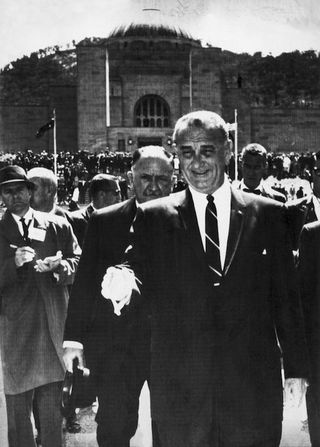
After having served as Texas secretary of state between 1937-1938, Ed Clark served as a US Army captain during WWII. Upon his return he engaged in political lobbying for the oil industry, served as chairman of Texas Commerce Bank and the First National Bank of Saint Augustine, and in 1948 was appointed as Johnson’s legal counsel and, much later, as ambassador to Australia in 1965 — one week shy of a 12-month vacancy at the Canberra mission. Clark quickly made up for lost time, and oversaw the development of a warm relationship between Johnson and Australian Prime Minister Harold Holt, which did much to amplify US influence in Australian public and political spheres — the first US presidential visit to Australia (October 1966) occurred on Clark’s watch, after Holt had offered his famous “all the way with LBJ” remarks on the White House lawn in July 1966 with the ambassador in attendance. Clark wrote that he was convinced that Johnson’s visit would “have a tremendous lasting effect on Australia’s thinking, on its economy, the policy in terms of Asia and elsewhere, and of course in US-Australian relations”. Clark himself was hugely popular in Australia and was regarded in both Canberra and Washington as one of the most successful ambassadors the United States had ever sent. He remained engaged in politics after departing Australia, and supported the presidential campaigns of both Nixon and Reagan.
William Cullen Battle
13 July 1962 — 31 August 1964
Lawyer and political campaigner
John F. Kennedy, Lyndon B. Johnson
Battle served in the US Navy during WWII, in the same squadron as future US President John F. Kennedy. After returning to the United States to practice law after the war, in 1960 Battle worked on candidate Kennedy’s presidential campaign, consolidating a close relationship. Battle was appointed ambassador to Australia in 1961, during which time finalised several agreements and treaties, including the 1963 Status of US Forces Agreement. Battle also briefed and coordinated with Prime Minister Robert Menzies on the potential Soviet nuclear missile threat emanating from Cuba, allegedly issuing a pointed reminder to Menzies of his previous statement that evidence of an offensive Soviet threat in Cuba would automatically trigger Australia’s ANZUS obligations. However, JFK’s assassination in 1963 reportedly sapped Battle’s enthusiasm for public service, from which he retired the following year.
William Joseph Sebald
7 June 1957 — 31 October 1961
Career foreign service
Dwight Eisenhower
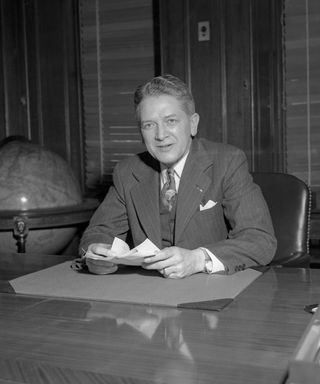
After ten months without an ambassador in Canberra, Sebald was the first Career Foreign Serviceman to assume the post. His decorated career included assignments at the Allied Headquarters diplomatic division in post-war Japan (1947-1952), as ambassador to Burma (1952-54), and three years at the State Department. The Canberra posting began in bizarre fashion, with Australian Customs seizing a shipment of Salinger’s Catcher in the Rye on grounds of inappropriate content, only to discover that the shipment was actually a gift from Sebald to the Australian people. While Sebald’s assignment focused primarily on reassuring Australia about Japan’s peaceful intentions and pursuing revisions to the bilateral security treaty, Washington’s position vis-a-vis Communist China was also the source of some minor tension in Canberra. Sebald’s maiden speech as ambassador clearly stated Washington’s non-recognition policy of Beijing at a time when Australia was reconsidering its own approach to relations with mainland China, and the ambassador was criticised for lecturing the Australian people on how to formulate China policy. Sebald maintained that officially recognising Communist China would “have a chain-reaction effect which would seriously weaken the free world”. Allegations were later made that a US Embassy official had tried to bribe a Labor senator not to visit the PRC with a party delegation in 1957.
Douglas Maxwell Moffat
27 March 1956 — 30 August 1956
Lawyer and public servant
Dwight Eisenhower
During WWII, Moffat had served as deputy alien property custodian in Manila, the Philippines, and was Washington’s principal representative at the Middle East Supply Centre at Cairo, Egypt, in 1943. Immediately prior to his appointment as ambassador, Moffat practiced law in New York and was well-known for his service as a member of the city’s Transit Authority from 1953-1956. Moffat was also the first and only US ambassador to Australia to die on the job — from health complications in August 1956, only three months after presenting his credentials in Canberra.
Amos Jenkins Peaslee II
12 August 1953 — 16 February 1956
International lawyer
Dwight Eisenhower
Prior to the ambassadorship, Peaslee was a member of the United States Council of Defense during WWII and part of the US delegation to the 1919 Versailles Peace Talks, while he later rose to become president of the American branch of the International Law Association and first secretary of the International Bar Association. Peaslee’s prestige within the Republican Party secured his nomination for the Canberra posting, having long maintained a close association with the party as a founding member of the New York Young Republican Club, New Jersey delegate to the Republican National Conventions of 1948, 1952 and 1956, and former member of the New Jersey Republican State Committee and Finance Committee.
The ambassador had issued a stern rebuke to the Prime Minister Robert Menzies for suggesting a diplomatic solution to growing tensions with China over Taiwan that would have effectively recognised Beijing’s status as an international entity on par with the Soviet Union.
Peaslee’s belief in the evergrowing importance of Australia to US interests in the Asia Pacific had motivated him to pursue the ambassadorship in Canberra. Even so, his tenure coincided with a hardening of US policy against communism in Asia in the aftermath of the Korean War, a policy often at odds with the Australian government’s own approach to engagement with China in particular. For instance, the ambassador had issued a stern rebuke to the Prime Minister Robert Menzies for suggesting a diplomatic solution to growing tensions with China over Taiwan that would have effectively recognised Beijing’s status as an international entity on par with the Soviet Union.
Peterson Bryant Jarman
7 September 1949 — 31 July 1953
Congressman
Harry Truman
Jarman was the first US congressman to serve as ambassador to Australia, having served in six successive congresses from 1937-1949. He was appointed US ambassador to Australia by Truman in 1949, though not without controversy — Jarman allegedly applied for the ambassadorship out of financial expediency, and was supposedly granted the position as part of the Truman administration’s tactic of exiling ‘troublesome’ politicians. On top of ongoing difficulties in Washington’s relationship with Australian Minister for External Affairs Herbert Evatt, the nature of Jarman’s appointment may have contributed to perceptions that Washington “was not placing high priority” on the bilateral relationship with Australia.
Myron Melvin Cowen
20 August 1948 — 17 March 1949
Lawyer and public servant
Harry Truman
Cowen practiced law in Des Moines, Iowa, between 1919 and 1926, before he was elevated to the position of commissioner for the US Court of Appeals in Washington. In 1933 he returned to practicing law, before he was appointed US ambassador to Australia in 1948. His stint in Canberra did not even last a full year — at his own request, he was reassigned to the Philippines despite the efforts of Minister for External Affairs Evatt to obstruct his relocation. It has been suggested that, as a result, Cowen was instrumental in having Evatt replaced by Philippine diplomat Carlos Romulo as president of the UN General Assembly.
Robert Butler
25 September 1946 — 31 March 1948
Businessman
Harry Truman
Although Norman Makin was technically the first US ambassador to Australia after bilateral relations were upgraded from legation to embassy status, his appointment lasted only two weeks before Robert Butler arrived in Canberra. During the Second World War, Butler had been president of the ship-building company Walter-Butler Shipbuilding which produced more than 80 military vessels including frigates and cargo ships. He was appointed ambassador to Australia by President Truman in 1946, though his official credentials contrasted poorly with Australia’s own choice of ambassador to Washington — former government minister and first president of the United Nations Security Council Norman J. Makin. Even so, Butler was was by most accounts well-received in spite of his diplomatic inexperience and Washington’s difficult relationship with External Affairs Minister Herbert Evatt.



